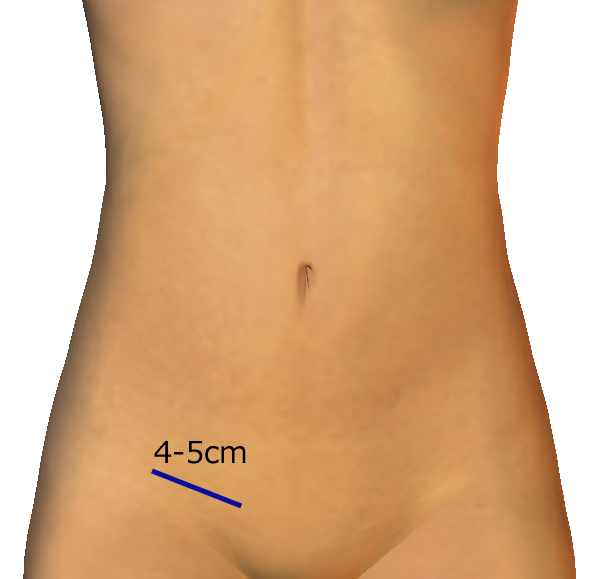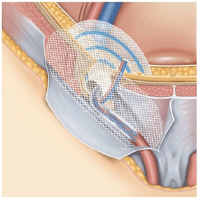
Inguinal hernias
Consultations
Why do inguinal hernias occur in adults?
The word “hernia” indicates a condition in which organs and other tissues do not remain in their original location inside the body, but are protruding through a weak area in the muscular wall to form a bulge under the skin.
A hernia is normally prevented from developing by the action of the fascia and aponeurosis attached to back of the muscles forming the abdominal wall.
If the metabolism of the underlying fascia and other tissues become defective, the muscles and tendons will weaken, and a hernia can develop at such a weak spot.
The reason for defective metabolism is unknown, but it is known that the incidence increases with increasing age.
Since metabolic defects occur bilaterally, inguinal hernias are likely to occur on both sides, or after receiving treatment for an inguinal hernia on the one side, it may also develop on the other side after a while.
The possibility of having to undergo surgery for an inguinal hernia in one’s life is considered to be 27.2% for men and 2.6% for women.
Can an inguinal hernia in an adult heal spontaneously?
No, an inguinal hernia in an adult cannot heal by itself.
The only treatment available is surgical repair.
What happens if an inguinal hernia in an adult is not treated (surgically)?
The bulge of the hernia can often be spontaneously reduced (the content returns to the inside of the abdominal cavity) by reducing pressure on the abdomen (for example, by lying down). When the patient stands up again or pressure on the abdomen increases for other reasons, the bulge will reappear.
It may become impossible for the bulge to return into the abdomen, a condition that is called incarceration. Incarceration is a very dangerous condition, and emergency surgery is usually required. If the blood flow to the intestines is cut off or if necrosis occurs, it is a life-threatening situation that can be fatal.
Men
Within 10 years of deciding not to undergo surgery, 70% of patients will undergo surgery for any of the following reasons:
- The hernia becomes painful.
- The bulge becomes larger
- The hernia becomes bothersome in daily life
- The patient requests surgery
- Emergency surgery becomes necessary
Emergency surgery is performed in approximately 2% to 5% of cases.
Women
Since there are no reports of long-term observation of inguinal hernia following a wait-and-see approach, we do not know what happens if an inguinal hernia in a woman is not treated. It is however known that emergency surgery is more frequently required than in men, and surgery is recommended for all cases, in principle.
Which treatment methods are available?
The metabolic defect continues to be present after surgical repair of the hernia. In case of simple repair by stitching, as used to be done in olden times, the wound area will weaken over time, and the hernia may recur. It is therefore necessary to use synthetic mesh to repair the hernia.
【1. Using the patient’s own tissue to repair the hernia】
With this treatment method, a patient’s own tissue is used to repair the weakened area by stitching it.
One advantage of this method is that infection is less likely to develop than with a synthetic membrane (mesh) patch since the patient’s own tissue is used.
A disadvantage of the method, however, is that already weakened tissue in the area is used for the surgery, increasing the possibility of recurrence, and patients also may have stronger post-operative pain that lasts longer.
This classical method is presently only used under very special circumstances.
【2. Using synthetic mesh to repair the hernia】
With this treatment method, the weakened part of the abdominal wall is reinforced using a synthetic membrane (mesh) patch made of material that does not cause any problems when implanted in the human body.
Advantages of this method include a low incidence of recurrence of hernia and relatively mild post-operative pain.
Disadvantages include higher susceptibility to infection than when the patient’s own tissue is used, and post-operative pain that may rarely continue for a long time.
Surgical repair using synthetic mesh has become the current mainstream method of treating inguinal hernias in adults, and almost all cases are treated this way.
Surgical procedures using synthetic mesh are largely divided into two types: open repair and laparoscopic repair.
Open inguinal method of making an incision through the skin covering the bulge of the hernia to repair it


Synthetic mesh is used to repair the weak part through the abdominal incision.
The hernia is repaired from outside the body.
Laparoscopic repair by making small incisions at some distance from the hernia

Three small incisions are made in the abdominal wall, and special surgical instruments are inserted through these openings to do the repair.

Special surgical instruments are inserted through the openings and a synthetic mesh patch is used to repair the defect.

The hernia is repaired from inside the body.
Which method of repair is better?
The best procedure for every patient depends on the patient’s general physical condition and the past medical history, and differs for every case.
Hernia specialists will determine the best treatment based on every patient’s individual situation.
Please see the 2015 Inguinal Hernia Treatment Guideline of the Japan Hernia Society, for the general treatment methods available.
Surgery-related statistics
Both open inguinal surgery and laparoscopic procedures are performed
Since 2004, we have performed more than 1800 surgical procedures for inguinal hernia at this center, and postoperative recurrence occurred in 3 cases only (0.16%).
Since 2013 laparoscopic repair is also available for inguinal hernias, and we have performed more than 400 laparoscopic procedures for inguinal hernias so far, with no cases of postoperative recurrence, 1 case of intestinal obstruction (0.25%) and 2 cases of injury of the vas deference(0.5%).
In Japan there is not an official certification system for inguinal hernia repair techniques, but certification is available for laparoscopic hernia repair, and of the only 66 surgeons who have received certification as of July 2017, two are performing laparoscopic hernia repair procedures at this center on a full-time basis.

